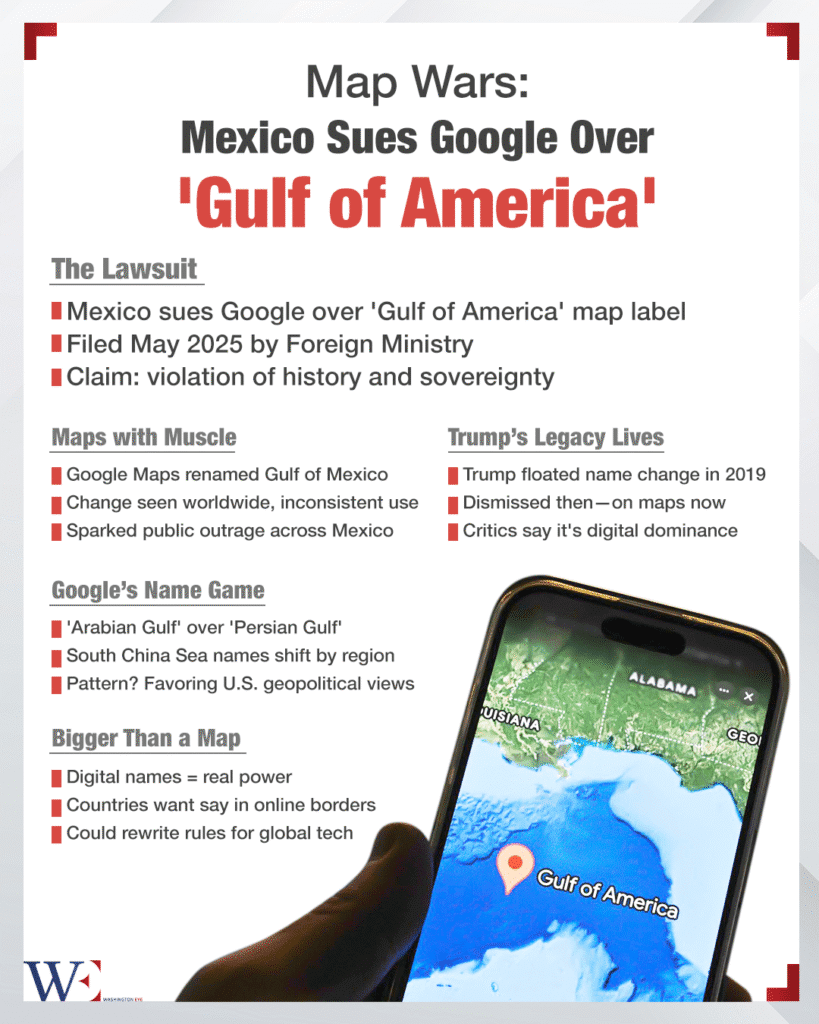A geopolitical and cultural controversy erupted this month as the Mexican government filed a formal lawsuit against Google for labeling the “Gulf of Mexico” as the “Gulf of America” on its Maps platform. The complaint was initiated by Mexico’s Secretariat of Foreign Affairs, which accused the tech giant of propagating an inaccurate and potentially harmful designation that undermines Mexico’s territorial integrity and regional sovereignty.
The erroneous label, first noticed by Mexican users in late April 2025, sparked public outrage and quickly gained traction online. The name “Gulf of America” reportedly appeared on mobile and desktop versions of Google Maps in various global regions, though inconsistently. Mexican officials claim the rebranding has its roots in a proposal floated by former U.S. President Donald Trump during his term—a rhetorical gesture at the time, but now alarmingly materialized on a widely used digital platform.
Cultural Sovereignty in the Age of Algorithmic Cartography
What appears on digital maps is no longer a neutral representation of geography—it has become an expression of digital authority and soft power. Mexico’s lawsuit underscores the increasing importance of cartographic narratives in shaping public perception and national identity in the digital age. Mexican Foreign Minister Alicia Bárcena stated that “altering the name of such a critical geographic region is an affront to our cultural heritage and an insult to historical truth”.
Indeed, the Gulf of Mexico is not just a body of water; it is deeply tied to Mexico’s economic lifelines, including oil exports, fisheries, and maritime trade. Rebranding it as the “Gulf of America” subtly erodes that connection and may reinforce hegemonic discourses in which U.S. interests supersede regional histories. The choice of words in digital infrastructure has real-world consequences—both symbolic and legal.
A Pattern of Digital Favoritism Toward U.S. Interests?
Mexico’s concerns are not isolated. This isn’t the first time Google Maps has been accused of adopting naming conventions that appear to favor U.S. geopolitical narratives. In the past, Google Maps has referred to the waters around Cuba using outdated Cold War-era labels and has controversially omitted or diminished indigenous place names in North America.
Perhaps more prominently, the tech giant drew criticism for defaulting to U.S. government terminology in disputed territories. For instance, it long referred to the body of water between Iran and the Arabian Peninsula exclusively as the “Arabian Gulf”, a term favored by the United States and Gulf Arab states, instead of the internationally recognized “Persian Gulf”—a decision that drew protests from Iranian officials and scholars. Similarly, in the South China Sea, while Google has sought to maintain neutrality, it has been accused of tailoring map versions depending on the geopolitical preferences of the country from which users are accessing the service—thus indirectly validating national claims.
Critics argue these inconsistencies reflect an underlying bias that often leans in favor of U.S. narratives or avoids challenging them. The case with Mexico appears to be an extension of this trend—where a name rooted in Trump-era jingoism has inexplicably entered mainstream cartography through digital platforms without diplomatic review or regional consensus.
Implications for Tech Accountability and Digital Diplomacy
Mexico’s legal challenge signals a broader trend of governments asserting sovereignty over digital representations. While companies like Google have long argued that content on their platforms reflects “aggregate user input” or relies on external data sources, such justifications are increasingly being questioned in courtrooms. Google has yet to formally respond to the lawsuit but stated it is “investigating the matter”.
If Mexico succeeds, the case could set a legal precedent requiring digital platforms to be more transparent and accountable in how they label geopolitical entities. Moreover, this lawsuit may encourage other nations to audit digital cartographic representations and push back against what they perceive as unilateral cultural impositions.
Political Undercurrents and the Trump Legacy
The roots of the “Gulf of America” label trace back to a Trump-era social media campaign that sought to emphasize American dominance in the hemisphere. In a now-archived 2019 post, Trump casually floated the idea that the Gulf should be renamed in honor of the United States’ naval and economic presence in the region. While widely dismissed as jingoistic bravado at the time, the recurrence of the label in a major tech product raises questions about how fringe political rhetoric can find new life through digital channels.
The lawsuit is also politically charged within Mexico, with nationalist factions framing it as a necessary defense of dignity against “digital imperialism”. Critics, however, suggest that the lawsuit may be a diversion from domestic challenges facing President Claudia Sheinbaum’s administration.
A Final Note: Redrawing the Map in the Cloud
This conflict over a map label is emblematic of larger tensions in a world where information is mediated by algorithms, and even geographical truth is subject to dispute. The case invites us to reflect on who holds the authority to define spaces in the digital domain and what responsibilities come with that power. Whether Mexico wins its lawsuit or not, the message is clear: digital platforms are now arenas of international diplomacy, and what they display is anything but trivial.



















